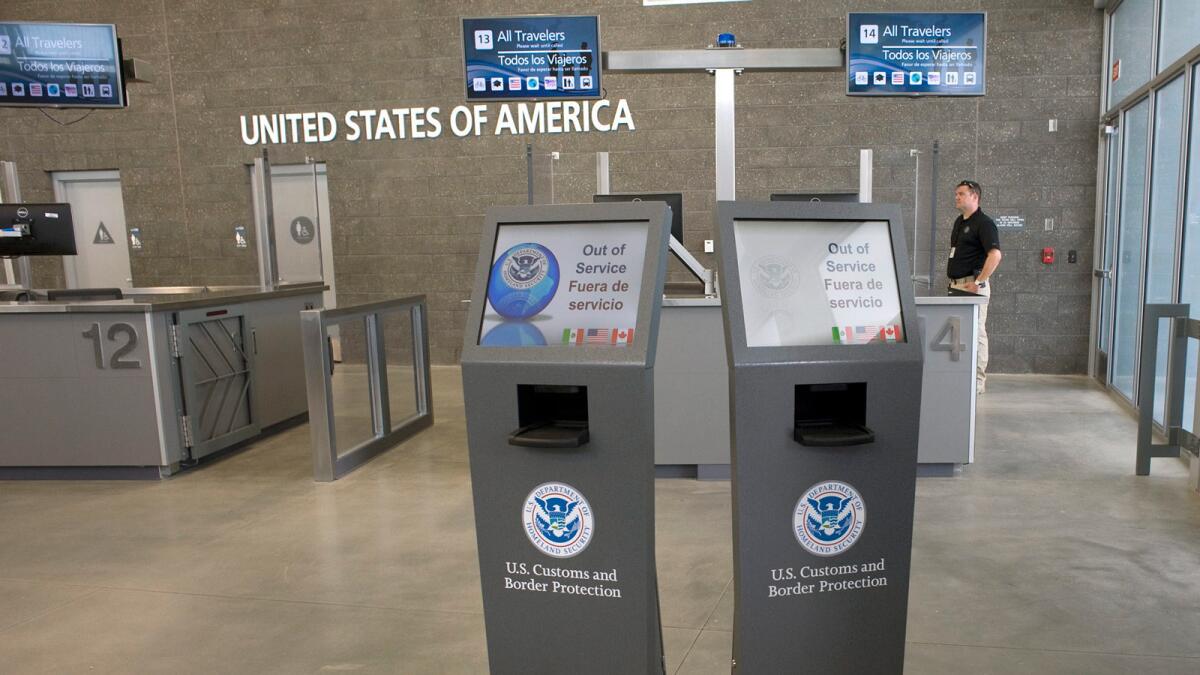On the Spot: Border-crossing protocols and bearing up as a parent of itinerant teens

- Share via
Question: A friend of mine found herself in trouble. She is 16 and recently went with a man to Tijuana, and upon her return she was challenged by the Border Patrol. She had a California ID, but the agent wanted her to produce a passport or passport card, which she didn’t have. She was forced to remain in the country. What do you advocate for U.S. citizens going across the Mexican or Canadian border and especially taking underage females across the border who are not your relative?
C. Johnson
Sylmar
Answer: Taking an underage girl to a foreign country from the U.S. (or allowing oneself to be taken, if indeed she had a choice) is such a spectacularly bad idea for so many reasons that I am stunned into near silence.
But it’s “near” silence, not complete silence, and with help from two entities, I can respond. The first is the State Department (and its website, www.travel.state.gov). The second is from the mother of five daughters who spoke frankly about the perils of raising them. This wasn’t our first conversation on this topic, by the way; she is my sister.
First for the official issues — and there are many and they apply not just to those sneaking across the border but to those who are, say, going on an Alaskan cruise, which will, by law, take you to a foreign country. Here’s the deal:
If you are going to a foreign country, you need more than just your driver’s license unless it’s an enhanced driver’s license, which Washington state has but California does not. Customs and Border Protection has a list of acceptable documents at www.lat.ms/documents. The top two documents are a passport or a passport card. The card is less expensive.
Once upon a time you could go back and forth between the U.S. and Mexico, Canada and some Caribbean nations with nothing more than a voter registration card or a birth certificate.
Those days came to a screeching halt after 9/11 and the birth of the Intelligence Reform and Terrorism Prevention Act of 2004, which mandated better border protection. Part of that protection was higher-quality documents attesting to who you are.
The first phase of the Western Hemisphere Travel Initiative required documentation for air travel that returned you to the U.S.; the second phase, implemented in June 2009, included land and sea travel.
If the teenage girl in question were younger than 16 and coming from Mexico, Canada or the Caribbean, she would have to present only an original birth certificate, consular report of birth abroad, a naturalization certificate or a Canadian Citizenship Card, according to the State Department’s FAQs (www.lat.ms/statefaq).
But this person was 16 so she needed a passport, a passport card or one of the other acceptable forms of identification.
The question that may now arise is why the State Department or Customs and Border didn’t stop her from entering Mexico. That’s not a question for those officials; it’s a question for Mexico’s officials. The State Department does not have what a spokesman called “exit control” over people leaving the U.S.
The big question is this: Where were her parents and what were they thinking?
It’s not entirely fair to blame them, said Judith Ramsey, my sister, who is not an unbiased source but who can claim that she raised five girls to adulthood with only a few brushes with authorities.
Did my nieces ever lie to their parents about where they were going, saying they were going some place authorized but then sneaking to some other place? “I’m sure,” she said, “but they took great pains to keep it from their dad and me.”
Having a built-in parental antenna is key to keeping them safe. “I think that’s one of the most important things that you as a parent have to do: You need to know where they are, when they are coming home, who they are with. [Plans] need to be concrete … because their sensibilities don’t recognize danger.”
So ask about their plans, and if there’s something they are trying to cover up? “They’ll always give you some flim-flammy answer,” she said. “You can tell when they get all blustery that that’s what they’re doing — trying to pull the wool over your eyes — but you can’t let them.
“Their judgment is not top drawer, and they think it is.”
And to parents who are struggling, she could offer only this: “Take your vitamins and hang on.”
It’s usually worth the perseverance. Even with the kid who insisted she had no idea why the new washing machine was scratched and later confessed it was because kids were hiding in the laundry room when the cops were called to break up an unauthorized party thrown “the one time we went away.” (That kid, by the way, is now a lawyer.)
As for the young woman who was detained in Mexico, she is entitled to consular assistance; a State Department spokesman said the country is required by law to notify the U.S. Embassy or Consulate. To see what the State Department can and cannot do when a U.S. citizen is arrested or detained, see www.lat.ms/arrest.
If someone you know finds himself or herself in such dire straits, you also can get in touch with the State Department to ask for help. The arrest page can direct you to the phone number you need.
Keeping U.S. citizens safe is the State Department’s No. 1 priority, a spokesman said. Sort of like a parent who is paying attention.
Have a travel dilemma? Write to travel@latimes.com. We regret we cannot answer every inquiry.
Sign up for The Wild
We’ll help you find the best places to hike, bike and run, as well as the perfect silent spots for meditation and yoga.
You may occasionally receive promotional content from the Los Angeles Times.




